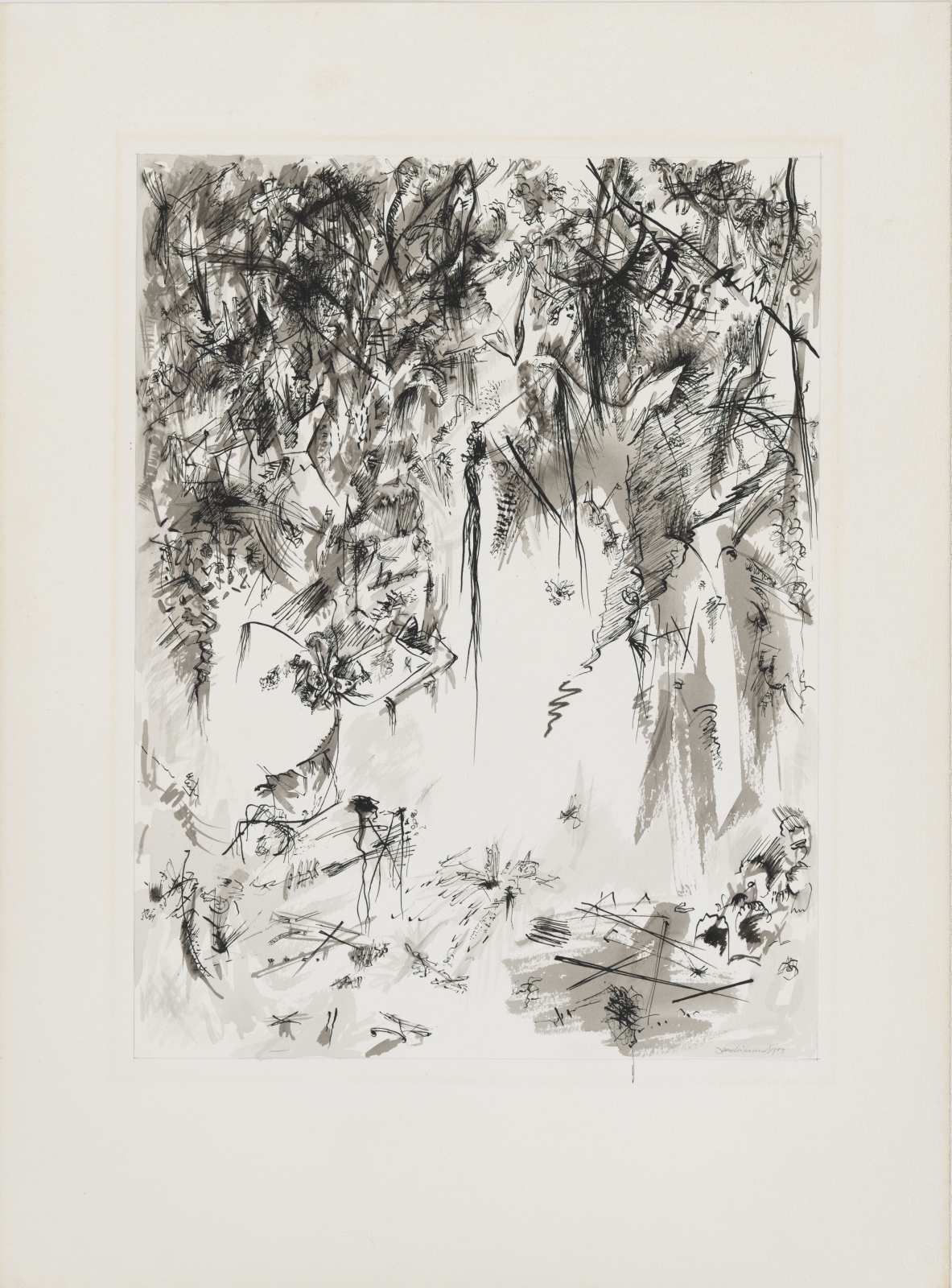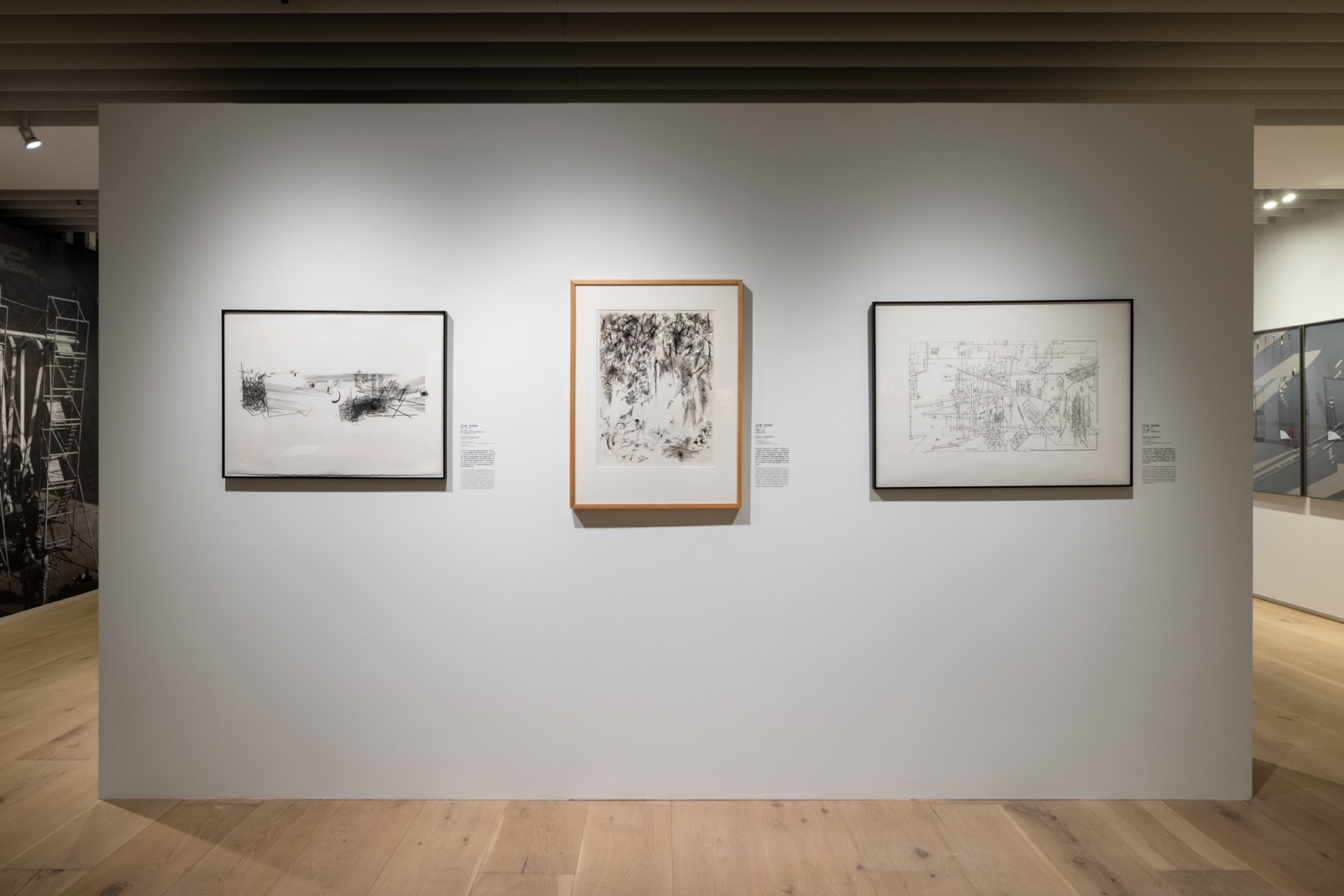
Daniel Libeskind, Theatrum Mundi, 1984. © Daniel Libeskind. From the Collection of the Alvin Boyarsky Archive.
|
丹尼爾.李伯斯金 《無題》,1984年 |
Daniel Libeskind Untitled, 1984 |
根據丹尼爾.李伯斯金的描述,《世界劇場》系列是在表現一座「在建築思想血液裡流動的核介質中產生的……被某種未知的傳染病圍困住的城市」。這個抽象的想法透過具有表現力的筆繪線條和墨水暈染化為圖像,比起建築圖稿來說,它更像是一件書寫或水墨的創作。其所稱的傳染病,是否和當時建成的建築狀態,或是跟實際的生化危機和全球性流行病有關?還是說,這份繪圖是在反思發生於20世紀的恐怖與災難事件,造成與硬體建設等量的建築破壞?所有的提問都集中在里伯斯金暗藏玄機的繪圖中,任由各方自由解讀。
Daniel Libeskind described his Theatrum Mundi series as a representation of a “city besieged by an unknown infection……taking place within the nucleic medium that flows in the bloodstream of architectural thought.” This abstract idea is visualized in expressive pen lines and ink washes more closely related to writing or calligraphy than architecture. Is the infection related to the state of built architecture of the time? To actual biohazards and pandemics? Or is this a reflection on the terrors and tragedies of the 20th century, which saw as much architectural erasure as construction? All these questions converge in Libeskind’s cryptic drawing, allowing its composition to be read in multiple ways.

Daniel Libeskind, Micromegas, The Garden, 1979. © Daniel Libeskind. From the Collection of the Alvin Boyarsky Archive.
|
丹尼爾.李伯斯金 《流亡花園》,1979年 |
Daniel Libeskind The Garden, 1979 |
丹尼爾.李伯斯金的《微型巨人》作品集,是援用伏爾泰於1752年發表的同名著作——這本堪稱科幻小說先驅之作的短篇寓言,內容描寫住在比地球大幾百萬倍的星球上的微型巨人造訪地球的旅程。既微型,又巨大,存在這個人物名稱裡的尺寸差異,為故事架構出一條主軸,而空間概念在故事發展中的分裂與合併,也反映在《流亡花園》這件作品上。熟悉的制式建築符號,失去了原本應有的邏輯,為經常以無法預期的方式交會的精準線條和形狀,預留了自由活動的可能。
The title of Daniel Libeskind’s Micromegas portfolio comes from the title of a 1752 short story by Voltaire—an early piece of science fiction that describes the journeys of Micromégas, an inhabitant of a planet millions of times the size of earth. The vast differences of scale alluded to in the character’s name serve as a theme within the story, and this play with spatial disjunction and conflation is also reflected in this print, The Garden. Familiar ruled architectural notations, without their expected logic, allow for the free play of precisely drawn lines and forms that often intersect in unpredictable ways.

圖:《聚變:AA倫敦建築聯盟的前銳時代》展場,左1為《V-水平》
|
丹尼爾.李伯斯金 《V-水平》,1983年 |
Daniel Libeskind V–Horizontal, 1983 |
《室內樂》系列的名稱所透露出的建築和音樂雙重含義,呼應著丹尼爾.李伯斯金在修讀建築之前曾受過的音樂訓練,而《V-水平》是在此漸進發展的系列中期左右出現。蛇形的曲線和俐落的直線組成的畫面,傳達出一股空氣流動的通透感。輕盈、密集的平行線上,為李伯斯金的樂曲充當空白樂譜的角色,而與建築有關的元素看似坐落於其上。這件圖稿所具體代表的圖像學究竟為何,至今依舊是個謎,而且對於理解AA作品集《室內樂》(Chamber Works)中的繪圖也是個充滿異議的話題,其中不少評論家將這些線條解讀為象形文字、音樂譜記和潛意識的幻覺。
The series title Chamber Works suggests both architecture and music, echoing Daniel Libeskind’s background in music prior to studying architecture. V–Horizontal appears toward the middle of this progressive series, and its scattered clusters of serpentine and ruled lines still convey a degree of airiness. Architecturally related elements seem to sit on masses of lightweight, condensed parallel lines that act rather like blank music sheets for Libeskind’s composition. The exact iconography of the piece remains a mystery and was a subject of great discussion on the pages of the Chamber Works AA Folio, in which various critics interpreted the lines as hieroglyphs, musical notations, and subconscious visions.
